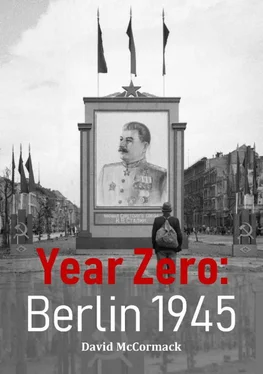On 31 January, forward elements of General Nikolai Bezarin’s 5 thShock Army crossed the frozen Oder to take the village of Kienitz by surprise. Over the course of the day, more units crossed over and expanded the initial lodgement to a width of six kilometres and a depth of two-and-a-half kilometres. Further reinforcements arrived in the form of a motorised battalion of the 219 thTank Brigade. The fragile ice on the river rendered the movement of armoured reinforcements impossible. As such, the lodgement remained vulnerable to counter-attack, however there were no major German formations available to clear up the Soviet bridgehead. An ad-hoc infantry-tank combat group was quickly assembled for an attack against the bridgehead. The attack launched on 1 February was supported by the teenage gunners of the 211 thFlak Regiment who laid down a barrage. By sheer chance the attack turned into a meeting engagement as the advancing German troops and armour stumbled into a Soviet attack being launched at the same time. The German assault lost momentum and stalled. Thereafter, the Luftwaffe was responsible for attempting to reduce the Soviet bridgehead.
Air attacks on Kienitz continued, with the harbour area being given special attention by dive bombers. Those who could, fled. Some inhabitants managed to make it to relative safety in the nearby villages of Wriezen and Ortwig. Many others tried to escape from the harbour area, but were killed in the heavy aerial bombardments. Kustrin had barely been declared a fortress, when elements of the Soviet 219 thTank Brigade burst into the Neustadt on 31 January. The attempt to take Kustrin by storm failed after three Lend-Lease Shermans and a Valentine were destroyed. General Chuikov then elected to lay siege to the so-called gateway to Berlin.
In early February, there were unmistakable signs that German resistance was stiffening. German garrisons continued to hold out stubbornly in Thorn, Schneidemuhl and Poznan. Soviet radio intercepts also began picking up increased signals traffic from 11 thSS Army and 3 rdPanzer Army that appeared to indicate an imminent counter-thrust from East Pomerania and Silesia. The Stavka recognised the danger and subsequently ordered Marshal Konstantin Rokossovsky’s 2 ndBelorussian Front to clear German forces from Pomerania and advance as far as Stettin.
On the night of 31 January, rain began to fall along the central sector of the Oder line. Over the following days, an early thaw set in, melting the snow and ice. In Berlin, chief press aide at the Propaganda Ministry, Wilfred von Oven, noted how the sudden change in the weather signalled a change for the better in the threatening situation in the east. His diary entry for 1 February has a distinctly optimistic tone:
The formerly threatening situation before Berlin has changed in our favour literally overnight. The splashing in the gutters sounds to our ears like the choirs of angels. The Oder and the Warthe, and the marshes of those two rivers and the Netze, together with a multitude of little water-courses have become obstacles which enable us to concentrate our defence on the threatened sectors.
The Oder ice melted at a satisfying rate, prompting Himmler to talk of a ‘miracle’. The Germans themselves contributed to speeding up the process by using explosives. The thaw turned dirt roads in western Poland into quagmires, further disrupting the flow of supplies to the Soviet fronts, whose logistical umbilical cord was already stretched to the limit. The thaw gave Hitler a moat and above all bought time in which the defences on the crucial central sector could be bolstered.
On 3 February, von Oven noted with some satisfaction the progress being made with defensive preparations during the unseasonably mild weather, ‘The thaw continues, mild spring air wafts through the streets of Berlin, and everywhere we are working energetically to build anti-tank obstacles and emplacements for the anti-tank guns’. That morning, the Americans attacked Berlin with a force of 1000 B-17 bombers and 575 P-51 Mustang fighters. This heavy raid destroyed large areas of Friedrichstadt, Luisenstadt, Kreuzberg, Mitte and Friedrichshain. In Mitte, the flooded air-raid shelter at the Adlon Hotel was crowded with Foreign Ministry officials. Press officer Hans Georg von Studnitz recorded his impressions of the raid:
The attack began at 10.45 am. and ended at 12.30. The Adlon shelter is a foot deep in water which has leaked through from the melting snow above. Many people had to wade about underground for two hours in icy water. Under the heavy explosions the massive shelter swayed and shivered like the cellar of an ordinary house. Finally all the lights went out and we felt that we had been buried alive.
The bombs used in the raid were mostly high explosive types. Fires raged in some areas for four days. This was the nearest Berlin ever came to experiencing a fire storm.
Meanwhile, back at the battlefront, the anticipated German counter-attack (code-named Operation Solstice) was launched on 16 February. Despite intelligence gained from radio intercepts, Zhukov lacked detailed information regarding the attack’s timing and objectives. Consequently, the assault made by the 11 thSS Panzergrenadier Division achieved complete tactical surprise, resulting in a break-through to Arnswalde and the relief of its beleaguered garrison. Hot on the heels of this early success, elements of 11 thSS Panzer Army attacked the following day and recaptured Pyritz. However, the hastily assembled and relatively inexperienced units committed to the attack failed to consolidate their early gains. Consequently, the attack lost momentum, due to a combination of stubborn Soviet resistance and the thaw which had turned the battlefield into a quagmire.
On 17 February, General Walter Wenck was seriously injured in a car accident whilst returning to the front after a meeting with Hitler in Berlin. The loss of this dynamic commander was a severe blow as he had led the attack with characteristic skill and vigour. His replacement, General Hans Krebs ordered the attack to continue, but the initiative had been lost. Following the costly failure of Operation Solstice, all the signs pointed to an impending drive on Berlin by Zhukov and Konev’s fronts. Unbeknown to the German High Command, their hastily conceived offensive had an impact on Soviet operational thinking which was totally out of proportion with the results achieved on the battlefield. The surprise German attack prompted the Stavka into considering the need to clear the flanks before launching their drive on Berlin. Between 17–22 February, Zhukov and Rokossovsky received orders to launch a joint attack aimed at Kolberg, Danzig and Gydnia. Rokossovsky attacked on 24 February, and within two days had smashed the German defences along a fifty kilometre front, penetrating to a depth of forty-five kilometres. Zhukov attacked northwards on 1 March, perplexing German planners who expected a full-blooded drive on Berlin. By 5 March, his forces had reached Stargard and Kolberg.
For Hitler, the Red Army’s halt on the River Oder signalled a lifeline. Surely the west would come to its senses and realise that the Soviet Union was the real enemy? Wiser heads dismissed Hitler’s assertions as sheer fantasy. Guderian saw the lull for what it was – a temporary reprieve. There was however still much to be gained from what little time there was left. For Guderian, replacing the dilettante commander of Army Group Vistula was a priority. Himmler had been an abject failure. His dreams of winning the coveted Knights Cross had come to nothing. In the event, Guderian experienced little trouble in persuading Himmler to relinquish his command. His successor, Colonel General Gotthard Heinrici was a man of a different stripe.
Heinrici was a noted expert in defence who had achieved considerable success whilst commanding 1 stPanzer Army in Hungary. To hold back the massive Red Army forces building up on the Oder, he had at his disposal General Hasso von Manteuffel’s 3 rdPanzer Army and General Theodor Busse’s 9 thArmy. Between them, these two formations covered a front of 281 kilometres stretching from the Baltic coast to the confluence of the Oder and the Neisse in Silesia. Heinrici’s strongest formation was Busse’s 9 thArmy which had succeeded in maintaining communications with Kustrin along a single narrow corridor.
Читать дальше












